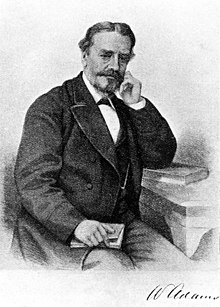William Adams (engineer)
William Adams (born October 15, 1823 in Mill Place, † August 7, 1904 in Putney ) was the locomotive operator of the North London Railway from 1858 to 1873, the Great Eastern Railway from 1873 to 1878 and the London and South Western Railway from 1878 until his retirement in 1895. He is known for his steam locomotives , specifically the Adams bogie , a machine with side centric springs (which were initially made of rubber) to improve stability at high speeds. He is not to be confused with William Bridges Adams (1797–1872), another locomotive engineer who, confusingly, invented the Adams axle - a radial axle used on locomotives by William Adams.
life and work
Adams was born on October 15, 1823, in Mill Place, Limehouse , London, where his father was an engineer with the nearby East and West India Docks Company. After attending a private school in Margate , Kent , he apprenticed in the same place as his father. Railroad surveyor Charles Vignoles had previously worked on the construction of the London harbor docks and his company secured Adams a position as an assistant in the drawing office. He spent the last years of his apprenticeship in the Orchard shipyard of Miller & Ravenhill, a manufacturer of engines for steamers.
In 1848 Adams was employed by Philip Taylor, a hardware manufacturer, machine fitter ( historically: mill builder ) and former assistant to Marc Brunel , who had offices in Marseille and Genoa to build and install marine machinery. Speaking fluent French and Italian, Adams soon became the supervisory lead engineer of the Kingdom of Sardinia's fleet , although he was still nominally working for Taylor. In 1852 he married Isabella Park, the daughter of another English mechanical engineer who worked in Genoa, and returned to England.
After returning to England, Adams worked as an appraiser for possible routes for a railway on the Isle of Wight , as supervisor of the construction of the Cardiff docks and on the planning of new production facilities in Bow near London for the East & West India Docks & Birmingham Junction Railway, which soon changed its name to North London Railway . This led to his appointment as the company's locomotive engineer in 1854, a post he held for eighteen years. It was here that he manufactured his famous series of 2'B locomotives, the first to have side-suspension chassis and the first continuous train brake (the Adams Bogie ).
In 1873 Adams took a similar position on the neighboring Great Eastern Railway (GER). Here he did not cope so well with the requirements and his locomotive designs for the company, a widely dispersed corporation compared to North London, were undersized for work on the main line. But his upgrading of the Stratford plant to modern, standardized equipment saved the company a lot of money, so when he moved to the London and South Western Railway (LSWR) in 1878 his reputation was intact.
Adams designed five locomotives for GER, including two passenger tank locomotives in two sizes for the suburbs, an express train series and a design for heavy coal transports. The latter, the GER Class 527 , was the first 1'C range built for use in the UK, although it did not enter service until its successor, Massey Bromley , made some improvements to it.
At LSWR he designed 524 locomotives, managed the expansion of the Nine Elms works and the transfer of the carriage and wagon works to Eastleigh . For health reasons, he retired on May 29, 1895. He lived in Putney until his death on August 7, 1904.
swell
- ^ Obituary (obituary): William Adams, Proceedings of the Institute of Civil Engineers, London Volume 158, January 1904, p. 426 f.
- ↑ cf. Allen 1956, p. 95.
- ↑ cf. Allen 1956, p. 96.
literature
- Cecil J. Allen: The Great Eastern Railway, ed. Ian Allan, Hampton Court 1955, 2nd ed. 1956
- DL Bradley: LSWR Locomotives The Adams Classes , Didcot, England, Wild Swan Publications 1985
- George W. Carpenter: Oxford Dictionary of National Biography: William Adams Oxford University Press 2004
- Jack Simmons and Gordon Biddle: The Oxford Companion to British Railway History , Oxford University Press 1997
| personal data | |
|---|---|
| SURNAME | Adams, William |
| BRIEF DESCRIPTION | British locomotive engineer for the English Railways |
| DATE OF BIRTH | October 15, 1823 |
| PLACE OF BIRTH | Mill Place (London) |
| DATE OF DEATH | August 7, 1904 |
| Place of death | Putney |
